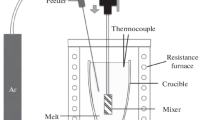Abstract
At atmospheric pressure, a commercial 85% alumina fails by granulation, breaking into small flakes and splinters with long dimensions parallel to the load axis. Replica transmission electron microscopy examination of polished surfaces on specimens loaded to 89% (or more) of the fracture stress reveals the formation of microcracks at crystal-glass interfaces subparallel to the load axis. Scanning microscopy of granulated samples indicates that pores in the material either initiate or channel the cracks which dissect the ceramic into small particles during granulation failures. Thus, the interpore spacing seems to be an important factor in the particle size distribution of the broken ceramic. In the faulting mode of failure, which occurs under confining pressure, the sliding faces of the ceramic are slickensided. However, most of the loose fracture particles do not display slickensides; in size and shape they resemble the powder produced by granulation failures. True “fault gouge” material, consisting of comminuted particles mashed together, tends to adhere to the fault faces. The gouge has a broad particle size distribution, including particles much finer than the interpore spacing of the ceramic. At the highest loading rate (0.81 sec–1 ) under atmospheric pressure, the particles produced by granulation fracture are slickensided and show evidence of either localized melting or plastic grooving induced by friction between adjacent particles.
Similar content being viewed by others
References
R. Arrowood andJ. Lankford,J. Amer. Ceram. Soc., submitted.
H. C. Heard andC. F. Cline,J. Mater. Sci. 15 (1980) 1889.
J. Lankford,ibid. 16 (1981) 1567.
Idem, Commun. Amer. Ceram. Soc. 65 (1982) C-122.
R. Arrowood,'ibid., submitted.
J. Lankford, W. L. Ko andU. S. Lindholm, “A Study of the Dynamic Strength and Fracture Properties of Rock,” Final Report, Advanced Research Projects Agency Contract No. HO 220063 (1973).
J. Lankford, in “Fracture Mechanics of Ceramics”, Vol. 5, edited by R. C. Bradt, A. G. Evans, D. P. H. Hasselman and F. F. Lange (Plenum, New York, 1983) p. 625.
Idem. J. Amer. Ceram. Soc. 62 (1979) 310.
Idem, ibid. 64 (1981) C33.
B. L. Karihaloo,Proc. R. Soc. A368 (1979) 483.
P. Tapponier andW. F. Brace,Int. J. Rock Mech. Min. Sci. 13 (1976) 103.
R. L. Kranz,ibid. 16 (1979) 23.
W. Janach,ibid. 14 (1977) 209.
D. H. Zeuch, D. V. Swenson andJ. T. Finger,Eos Trans. Amer. Geophys. Union 63 (1982) 1110.
C. S. Yust andR. S. Crouse,Wear 51 (1978) 193.
G. S. Lomdahl andR. McPherson,ibid. 73 (1981) 205.
J. Lankford andD. L. Davidson, in Proceedings of 3rd International Conference on Mechanical Behaviour of Materials, Vol. 3, Cambridge, UK, 20 to 24 August, 1979 (Pergamon, Oxford, 1980) p. 35.
Author information
Authors and Affiliations
Rights and permissions
About this article
Cite this article
Arrowood, R., Lankford, J. Compressive fracture processes in an alumina-glass composite. J Mater Sci 22, 3737–3744 (1987). https://doi.org/10.1007/BF01161487
Received:
Accepted:
Issue Date:
DOI: https://doi.org/10.1007/BF01161487




